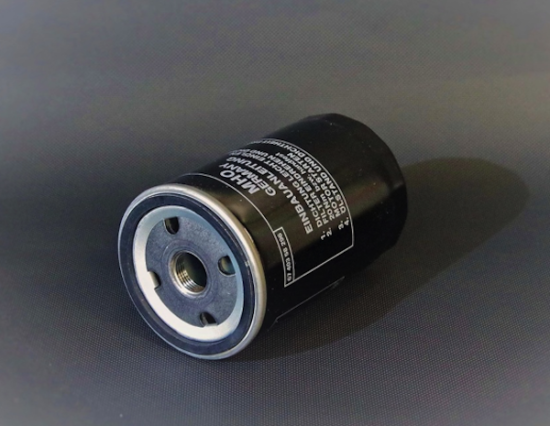The motor oil in your engine, and its additives, work to absorb and store inorganic and organic contaminants. The various organic contaminants may include oxidized oil, bugs, and bacteria. Inorganic impurities may include dust, wearing off of engine components, and metallic particles.
Therefore, motor oil helps with protecting the engine to improve its performance and efficiency. However, in order to prolong your engine’s life and offer better performance, oil filters are also installed by car manufacturers in order to clean oil prior to directing it into the engine’s vital moving parts.
Filter Media Types
Oil filters have various membranes or media that help filter out contaminants in the motor oil as it is circulating.
Cellulose filter media: Disposable oil filters typically come with cellulose filter media. This type of media is able to filter particulates that are 8 to 10 microns and clean as much as 40% of the motor oil. It is recommended that every 3,000 miles they are checked and replaced by your mechanic.
Synthetic filter media: Synthetic media is used by higher quality oil filters. This type of media is effective at removing 50% of particles that are 20 to 40 microns in size, and 24% of particles 8 to 10 microns in size. The vehicle lab details that every 5,000 to 7,000 miles this type of oil filter should be checked and replaced.
Microglass filter media: Microglass or a very fine metal media is used by most high-end oil filters. Microglass mesh is made out of fibers that is up to 10 times finer compared to cellulose fibers. Also, they place much less restriction on motor oil flow, and you only need to check and replace them every 10,000 miles or 3 to 5 years (whichever comes first).
Oil Filter Types
There is a broad range of different oil filters available in the market.
Primary oil filters: This type of oil filter is installed by a majority of car engine manufacturers. The oil filters are also called full flow filters. They filter 100% of the motor oil. It is absolutely essential that these oil filters work efficiently so that the engine stays lubricated. Therefore, their flow restrictions are lower.
Motor oil thickens in colder temperatures, and having a restrictive oil filter may end up damaging the engine. Therefore, primary oil filters only allow smaller contaminant particles to pass through. A fail-safe bypass valve is also installed by manufacturers in case the filter’s membrane gets too clogged. When a filter becomes clogged and doesn’t allow motor oil to get to the engine, the motor oil will be redirected by a specific pressure system around the membrane and into the engine so that it continues to be lubricated.
Secondary oil filters: Some manufacturers install secondary oil filters along with the primary oil filters. Secondary oil filters work on only around 1-10% of the motor and cleans it prior to routing it over the engine again. The secondary filters work independently from the primary oil filters and also help with removing additional contaminants.
Even if there is not a secondary oil filter on your vehicle, you can install one after buying it. This type of oil filter is also referred to as a bypass filter. It is important to keep in mind that they are totally different from the bypass valve detailed above.
Conventional oil filters: This kind of oil filter is a type of secondary filter and utilizes basic cellulose membranes. They filter smaller contaminants out, so they have to be replaced more often.
Thermal chamber oil filters: This type of oil filter works in two different ways. Motor oil is filtered in order to remove impurities and also its temperature is raised so that some of the contaminants inside the motor oil are destroyed or burn off. These oil filters are a way to refine the oil but you have to consume electricity in order to do so. That results in your car’s fuel efficiency being reduced.
Spinner filters: These are also referred to as centrifugal oil filters and use a spinning motion for trapping and holding motor oil contaminants. These oil filters typically contain two sections, a membrane and a housing chamber. Whenever media becomes clogged you just need to replace it but the housing chamber is still usable.
One of the most important components of the spinner filter is the base gasket. It helps to prevent leaking of motor oil but it isn’t very durable. If a spinner filter is used by your car, the base gasket should be checked by your mechanic once every 3,000 miles or every three months at least.
Magnetic oil filters: This type of oil filters removes metallic impurities out of the motor oil. However, they are not effective on dust. This type of oil filter does not need to be replaced. To keep it functional you just need to clean it periodically.
Keep in Mind
You should always use the oil filter that is recommended by your Original Equipment Manufacturer. Also, carefully follow the instructions on how frequent the oil filter should be replaced or maintained. Typically the instructions are based on mileage and the conditions you drive in regularly.
If you frequently drive in dusty conditions, you may want your oil filter to be checked more often.
Protecting Your Car
Your car is always going to be at risk of all different kinds of damages, and not just internal. If you’re going to be driving in dusty or rough conditions, you’ll want to invest in a clear bra, or other kinds of protection to ensure that your car isn’t damaged, nor your engine. It’s a simple solution.




Wow, I thought it as interesting when you explained that standard oil filters will clean 100% of the oil that moves through an engine. If I were to guess, the bigger the engine is, the bigger the oil filter will need to be. Replacing them on a regular basis is a good idea too so that the engine can stay in good condition.